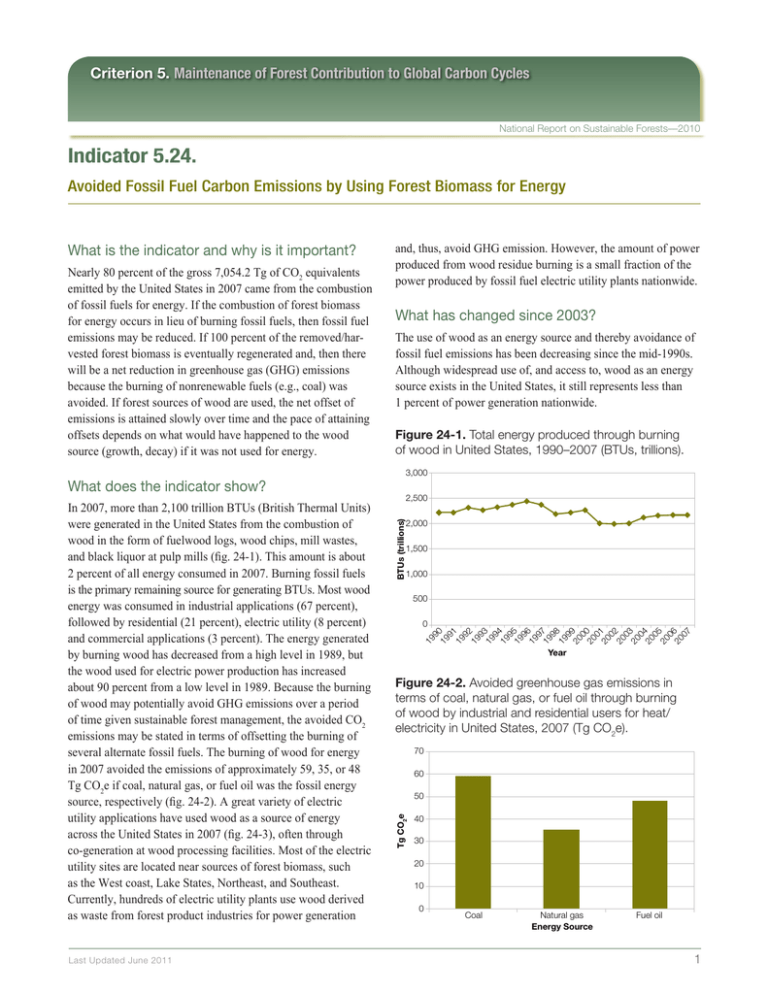Indicator 5.24. Criterion 5. Maintenance of Forest Contribution to Global Carbon Cycles
advertisement

Criterion 5. Maintenance of Forest Contribution to Global Carbon Cycles National Report on Sustainable Forests—2010 Indicator 5.24. Avoided Fossil Fuel Carbon Emissions by Using Forest Biomass for Energy What has changed since 2003? The use of wood as an energy source and thereby avoidance of fossil fuel emissions has been decreasing since the mid-1990s. Although widespread use of, and access to, wood as an energy source exists in the United States, it still represents less than 1 percent of power generation nationwide. Figure 24-1. Total energy produced through burning of wood in United States, 1990–2007 (BTUs, trillions). 3,000 What does the indicator show? Last Updated June 2011 BTUs (trillions) BTUs (trillions) 2,500 2,000 3,000 1,500 2,500 1,000 2,000 500 1,500 0 1,000 Year 500 Tg CO2e 19 9 19 0 91 19 92 19 9 19 3 9 19 4 9 19 5 96 19 9 19 7 98 19 9 20 9 0 20 0 0 20 1 02 20 0 20 3 0 20 4 05 20 0 20 6 07 Figure 700 24-2. Avoided greenhouse gas emissions in terms of coal, natural gas, or fuel oil through burning 60 of wood by industrial and residential users for heat/ Year electricity in United States, 2007 (Tg CO2e). 50 70 40 60 30 50 20 Tg CO2e In 2007, more than 2,100 trillion BTUs (British Thermal Units) were generated in the United States from the combustion of wood in the form of fuelwood logs, wood chips, mill wastes, and black liquor at pulp mills (fig. 24-1). This amount is about 2 percent of all energy consumed in 2007. Burning fossil fuels is the primary remaining source for generating BTUs. Most wood energy was consumed in industrial applications (67 percent), followed by residential (21 percent), electric utility (8 percent) and commercial applications (3 percent). The energy generated by burning wood has decreased from a high level in 1989, but the wood used for electric power production has increased about 90 percent from a low level in 1989. Because the burning of wood may potentially avoid GHG emissions over a period of time given sustainable forest management, the avoided CO2 emissions may be stated in terms of offsetting the burning of several alternate fossil fuels. The burning of wood for energy in 2007 avoided the emissions of approximately 59, 35, or 48 Tg CO2e if coal, natural gas, or fuel oil was the fossil energy source, respectively (fig. 24-2). A great variety of electric utility applications have used wood as a source of energy across the United States in 2007 (fig. 24-3), often through co-generation at wood processing facilities. Most of the electric utility sites are located near sources of forest biomass, such as the West coast, Lake States, Northeast, and Southeast. Currently, hundreds of electric utility plants use wood derived as waste from forest product industries for power generation 9 19 0 91 19 92 19 9 19 3 9 19 4 9 19 5 96 19 9 19 7 98 19 9 20 9 0 20 0 0 20 1 02 20 0 20 3 0 20 4 05 20 0 20 6 07 Nearly 80 percent of the gross 7,054.2 Tg of CO2 equivalents emitted by the United States in 2007 came from the combustion of fossil fuels for energy. If the combustion of forest biomass for energy occurs in lieu of burning fossil fuels, then fossil fuel emissions may be reduced. If 100 percent of the removed/harvested forest biomass is eventually regenerated and, then there will be a net reduction in greenhouse gas (GHG) emissions because the burning of nonrenewable fuels (e.g., coal) was avoided. If forest sources of wood are used, the net offset of emissions is attained slowly over time and the pace of attaining offsets depends on what would have happened to the wood source (growth, decay) if it was not used for energy. and, thus, avoid GHG emission. However, the amount of power produced from wood residue burning is a small fraction of the power produced by fossil fuel electric utility plants nationwide. 19 What is the indicator and why is it important? 40 10 30 0 Coal Natural gas Energy Source Fuel oil Coal Natural gas Energy Source Fuel oil 20 10 0 1 National Report on Sustainable Forests—2010 Figure 24-3. Location and avoided emissions (Tg CO2e) of public electric utilities using wood as a power generation source in lieu of burning coal in relation to aboveground forest biomass (Mg/ha), 2007. Coal offsets from biomass (Mg CO2e yr – 1) Greater than 50,000 25,001–50,000 10,001–25,000 5,001–10,000 Less than 5,000 Forest biomass (Mg CO2e ha– 1) Greater than 250 200.1–250 500 miles Albers Equal-Area Conic Projection Last Updated June 2011 150.0–200 100.0–150 Less than 100 2




